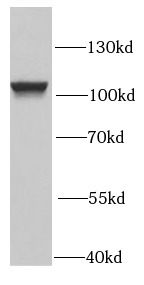Products
PSMD2 antibody
Category:
Research Area:
- SPECIFICATIONS
- Product Name
- PSMD2 antibody
- Catalogue No.
- FNab06887
- Size
- 100μg
- Form
- liquid
- Purification
- Immunogen affinity purified
- Purity
- ≥95% as determined by SDS-PAGE
- Clonality
- polyclonal
- Isotype
- IgG
- Storage
- PBS with 0.02% sodium azide and 50% glycerol pH 7.3, -20℃ for 12 months (Avoid repeated freeze / thaw cycles.)
Immunogen
- Immunogen
- proteasome (prosome, macropain) 26S subunit, non-ATPase, 2
- Alternative Names
- TRAP2 antibody
- UniProt ID
- Q13200
- Observed MW
- 108 kDa
Application
- Tested Applications
- ELISA, WB, IHC, IF
- Recommended dilution
- WB: 1:500 - 1:2000; IHC: 1:50 - 1:200; IF: 1:50 - 1:200
Validated Images
 SW480 cells were subjected to SDS PAGE followed by western blot with FNab06887(PSMD2 antibody) at dilution of 1:1000
SW480 cells were subjected to SDS PAGE followed by western blot with FNab06887(PSMD2 antibody) at dilution of 1:1000
 Immunohistochemistry of paraffin-embedded human liver injury using FNab06887(PSMD2 antibody) at dilution of 1:100
Immunohistochemistry of paraffin-embedded human liver injury using FNab06887(PSMD2 antibody) at dilution of 1:100
- Background
- The 26S proteasome is a multicatalytic proteinase complex with a highly ordered structure composed of 2 complexes, a 20S core and a 19S regulator. The 20S core is composed of 4 rings of 28 non-identical subunits; 2 rings are composed of 7 alpha subunits and 2 rings are composed of 7 beta subunits. The 19S regulator is composed of a base, which contains 6 ATPase subunits and 2 non-ATPase subunits, and a lid, which contains up to 10 non-ATPase subunits. Proteasomes are distributed throughout eukaryotic cells at a high concentration and cleave peptides in an ATP/ubiquitin-dependent process in a non-lysosomal pathway. An essential function of a modified proteasome, the immunoproteasome, is the processing of class I MHC peptides. This gene encodes one of the non-ATPase subunits of the 19S regulator lid. In addition to participation in proteasome function, this subunit may also participate in the TNF signalling pathway since it interacts with the tumor necrosis factor type 1 receptor. A pseudogene has been identified on chromosome 1. Alternative splicing results in multiple transcript variants of this gene.



